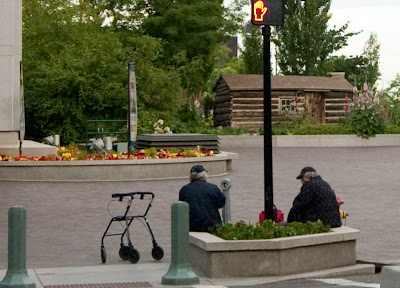I’m constantly in awe of the varying landscape, and can’t help but imagine what those eastern and mid-western travelers must have thought as they made their way through this larger-than-life country.
(Click on photos to view a larger image)
South of Lander WY

South of Lander the Atlantic City Road off Hwy 28 takes you to Atlantic City and South Pass City. I have never seen sky the color blue as it appears here. I suspect it’s the “thin air” that is responsible, and while it makes a beautiful sky it is not treating me well. I’m looking forward to reaching lower levels. Unfortunately, the camera doesn’t capture the true color.
Atlantic City WY

Wild flowers and blue sky

On my way to South Pass City I met Eric Bruntjen of Yakima WA, a bicyclist who was taking a short rest. We were the only ones on the road so I stopped to say hello. He was part of the Tour Divide race from Banff, Alberta, Canada to Antelope Wells, New Mexico. It follows the Continental Divide and attracts riders from our continent, Great Britain, and Europe. In addition to his bicycle gear he wore a GPS unit on his right shoulder that relayed his position at all times. He’d injured his ankle the day before and had spent the night in South Pass City, but he graciously let me take his picture. If you think you’re a top cyclist you can find info here - http://tourdivide.org/ where I read that Eric had finished the race on July 4th after three weeks on the road.
Eric Bruntjen

South Pass City had 2000 people by 1871 and was the seat of Carter County. Gold, the Carissa lode discovered in 1867, was the reason for its rapid growth. Remnants of the Carissa Mine still stand near the road outside the town. By 1875 South Pass City was almost a ghost town. Notice the sign proclaiming the first Masonic Lodge in Wyoming.
Carissa Mine

South Pass City

It was a South Pass City saloonkeeper and state senator, William Bright, who introduced a bill granting women the right to vote, hold office, and own property. When it passed in 1869, Wyoming women were the first in the country to participate in government.
On the way back to Hwy 28 I passed through varied landscapes, saw a couple of wary antelope, and waved to some semi-interested cattle.
Alone on the road

Antelope

Grazing Cattle

I crossed the Continental Divide at South Pass, 7550 feet above sea level, at 10:00 AM and glad to be descending to lower altitudes. Rolling prairie with the Wind River Mountains to the northwest are just as Alonzo described them when he passed this way on September 30, 1949 at 10:45 AM.
He wrote, “Very pleasant morning early, but the winds rose very high soon and blew a perfect gale from off the Wind River Mts. northward. A perfect storm of gravel and sand. It was rather tedious for our eyes. We passed over the great south pass of the Rocky Mts. midst this storm of earth. We crossed and bid the Sweetwater good-bye. Encamped on Pacific Creek 3 miles west of the pass.”
I traveled approximately the same path from Chicago in ten days that he covered in three months and twenty days, and I didn’t have to sleep under my transportation. I was always aware of the landscape and constantly imagined horses, wagons, and men--sometimes on foot--especially when the terrain was challenging, which was almost always.
The Oregon Trail continued west and followed the Sweetwater near Jeffrey City, rather than continuing north to Lander. It emerges from its path along the river and crosses Hwy 28 a few miles past the summit.
Wind River Mountains

Continental Divide, Elevation 7550'

Oregon Trail Marker

Next stop is Farson WY, where the altitude has dropped 1000 feet—a welcome place to pick up some lunch.
Farson WY

Immediately upon leaving Farson, Hwy 28 crosses the Big Sandy River; not to be confused with the Dry Sandy, the first stream emigrants reached after Pacific Creek, or Little Sandy, northeast of Farson. Alonzo mentions all three in his diary.
Big Sandy River History

Big Sandy River

The road passes through a barren, sandy area, known today as the Little Colorado desert or Badlands Hills, prior to meeting the Green River. After driving through the arid conditions I could understand Alonzo’s remark about the Green River, “Oh, it is a beautiful river.”
Badlands Hills

The Green River

Near the junction of Hwy 28 and the Green River I turn south on Hwy 372 and head towards I-80, one of the few times I’ve traveled on interstates. I’ve enjoyed these two-lane state and county roads all across the country. They have been free of traffic and billboards, and given me a chance to pull over for photographs or just gawk at the passing marvels without fear of an accident. Sometimes I went miles without passing another vehicle, and when I saw one they passed me at speeds far beyond the limit.
One last river to cross as I approach I-80 on Hwy 372, Blacks Fork, which flows through Fort Bridger, next stop on the journey. Alonzo described this area as ". . . a miserable country. The whole face of the country has been washed tremendously. The soil carried off (somewhere the Lord knows where, I don't)."
Approaching I-80 near Little America

Blacks Fork River


















































